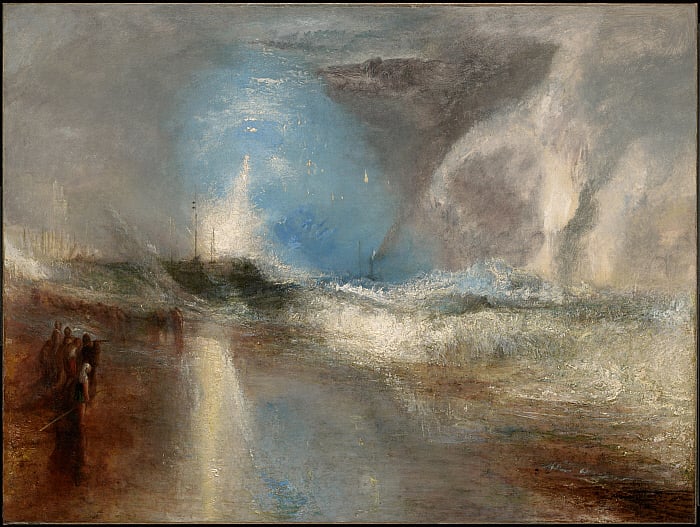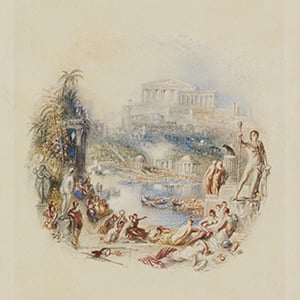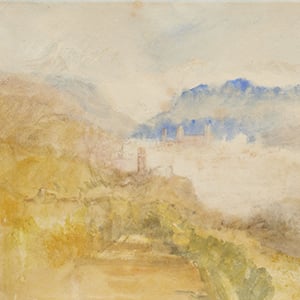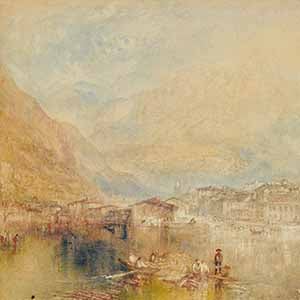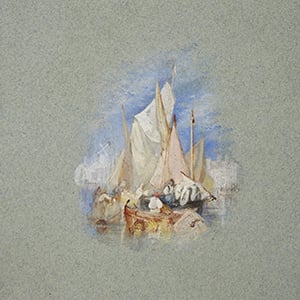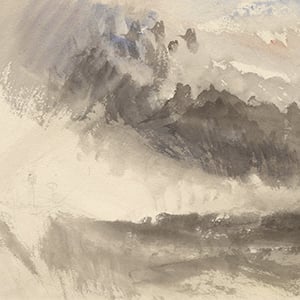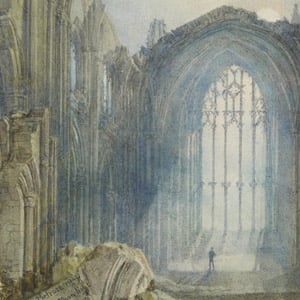Warrell, Ian ed.
J. M. W. Turner. Exhibition catalogue. London: Tate Publishing, 2007.
Dunstan, Bernard.
Painting Methods of the Impressionists. Revised edition. New York: Watson-Guptill, 1983.
Sterling and Francine Clark Art Institute.
List of Paintings in the Sterling and Francine Clark Art Institute. Williamstown, MA: Sterling and Francine Clark Art Institute, 1984.
Anonymous.
Turner. The Great Artists 1, part 4. London: Marshall Cavendish, 1984.
Gilbert, Rita, and William McCarter.
Living with Art. 1st edition. New York: Alfred A. Knopf, 1985.
Gilbert, Rita, and WIlliam McCarter.
Living with Art. 2nd edition. New York: McGraw-Hill, 1988.
Feldman, Edmund Burke.
Thinking about Art. Englewood Cliffs, NJ: Prentice-Hall, 1985.
Wittingham, Selby. "What You Will; or Some Notes Regarding the Influence of Watteau on Turner and Other British Artists."
Turner Studies: His Art and Epoch 1775–1851 5, no. 1 (Summer 1985): 2–24.
Rodner, William S. "Humanity and Nature in the Steamboat Paintings of J. M. W. Turner."
Albion 18, no. 3 (Fall 1986): 455–74.
Treuherz, Julian. "The Turner Collector: Henry McConnel, Cotton Spinner."
Turner Studies: His Art and Epoch 1775–1851 6, no. 2 (Winter 1986): 37-42.
Gage, John.
J. M. W. Turner: 'A Wonderful Range of Mind.' New Haven: Yale University Press, 1987.
Hermann, Luke. "John Landseer on Turner: Reviews of Exhibits in 1808, 1839 and 1840 (part 2)."
Turner Studies: His Art and Epoch 1775–1851 7 (Winter 1987).
Wilton, Andrew.
Turner in His Time. New York: Harry Abrams, 1987.
Nicholson, Kathleen. "Style as Meaning: Turner's Late Mythological Landscapes."
Turner Studies: His Art and Epoch 1775-1851 8, no. 2 (Winter 1988): 45–54.
Lukacher, Brian. "Turner's Ghost in the Machine: Technology, Textuality and the 1842 'Snow Storm.'"
Word and Image 6 (April–June 1990).
Gilbert, Rita.
Living with Art. 3rd edition. New York: McGraw-Hill, 1992.
Gilbert, Rita.
Living with Art. 4th edition. New York: McGraw-Hill, 1995.
Kern, Steven, ed.
List of Paintings in the Sterling and Francine Clark Art Institute. Williamstown, MA: Sterling and Francine Clark Art Institute, 1992.
Casteras, Susan P., et al.
John Ruskin and the Victorian Eye. Exhibition catalogue. New York: Harry N. Abrams; Phoenix: Phoenix Art Museum, 1993.
MacDonald, Margaret F.
James McNeill Whistler: Drawings, Pastels and Watercolors: A Catalogue Raisonné. London: Yale University Press, 1995.
Allen, Maureen.
Cressbrook. Kendal, Cumbria: Miller Turner, Ltd., 1996.
Kern, Steven, et al.
The Clark: Selections from the Sterling and Francine Clark Art Institute. New York: Hudson Hills Press, 1996.
Clark, Robert, and Thomas Healy, eds.
The Arnold Anthology of British and Irish Literature in English. London: Edward Arnold Publishers, 1997.
Adelson, Candace J. "Frits Thaulow's 'The Stream': George Eastman and Impressionism."
Porticus: Journal of the Memorial Art Gallery, Rochester 17–19 (1994–96): 45–9.
Gilbert, Rita.
Living with Art. 5th edition. New York: McGraw-Hill, 1998.
Hamilton, James.
Turner: A Life. London: Hodder & Stoughton, 1997.
Anonymous. "Nineteenth-Century Painting and Sculpture."
The Magazine Antiques 152 (October 1997): 522–31.
McCoubrey, John. "Turner's 'Slave Ship': Abolition, Ruskin, and Reception."
Word and Image 14, no. 4. (October–December 1998): 319–53.
Allen, Maureen. "Cressbrook."
Derbyshire Life and Countryside 63, no 1 (January 1998): 32–4.
Rodner, William S.
J. M. W. Turner, Romantic Painter of the Industrial Revolution. Berkeley: University of California Press, 1997.
Brown, Christopher K.
An Encyclopedia of Travel Literature. Denver: ABC-CLIO, 2000.
Pierce, Patricia Jobe.
Painters of the American Beach. Upcoming.
Harmon, William.
A Conspectus of the Arts: Turner, Wagner, Hardy. KnowledgeWorks Institute, University of North Carolina at Chapel Hill: 2002. CD-ROM.
Royal Academy of Arts.
Exhibition of Works by the Old Masters, and by the Deceased Masters of the British School, with a Selection of Works by the French Artists and a Collection of Plate and Other Objects Illustrating the Sculptor-Goldsmith's Art. Winter Exhibition, Twenty-Seventh Year. Exhibition catalogue. London: Royal Academy of Arts, 1896.
National Museum of Wales.
Catalogue of a Loan Exhibition of Paintings. Cardiff: National Museum of Wales, 1913.
Mahoning Institute of Art.
Catalogue of a Loan Exhibition of Paintings. Exhibition catalogue. Youngstown, OH: Mahoning Institute of Art, 1917.
Knoedler & Co.
A Loan Exhibition of Twelve Masterpieces of Painting. Exhibition catalogue. New York: Knoedler & Co., 1928.
Sterling and Francine Clark Art Institute
. Exhibit Four: First Two Rooms. Exhibition catalogue. Williamstown, MA: Sterling and Francine Clark Art Institute, 1955.
Sterling and Francine Clark Art Institute.
Exhibit Four & Exhibit Seven. Exhibition catalogue. Williamstown, MA: Sterling and Francine Clark Art Institute, 1958.
Burnet, John, and Peter Cunningham.
Turner and His Works: Illustrated with Examples from his Pictures, and Critical Remarks on his Principles of Painting. London: J. S. Virtue, 1852.
Burnet, John, and Peter Cunningham.
Turner and His Works 2nd edition. London: J. S. Virtue, 1859.
Thornbury, Walter.
The Life of J. M. T. Turner, R.A. 2nd edition. London: Chatto & Windus, 1877.
Wedmore, Frederick.
Turner and Ruskin. 2 volumes. [London?], 1900.
Bell, Charles Francis.
A List of the Works Contributed to Public Exhibitions by J. M. W. Turner,
R.A. London: G. Bell, 1901.
Armstrong, Sir Walter.
Turner. 2 volumes. London: T. Agnew; New York: Charles Scribner's Sons, 1902.
Webber, Byron.
James Orrock R. I., Painter, Connoisseur, Collector. 2 volumes. London: Chatto and Windus, 1903.
Macfall, Haldane.
The Modern Genius. History of Painting 8. London: T. C. and E. C. Jack, 1911.
Townend, Harry.
J. M. W. Turner. New York. 1923.
Falk, Bernard.
Turner the Painter: His Hidden Life. London: Hutchinson & Co., Ltd., 1938.
Frankfurter, Alfred. "Dark Horse in Williamstown."
Art News 54, no. 4 (Summer 1955): 28–31.
Comstock, Helen. "The Connoisseur in America—The Clark Collection Opens."
The Connoisseur (American ed.). 136. (January 1956).
Seiberling, Frank.
Looking into Art. New York: Holt, 1959.
Anonymous. "Painting."
Encyclopedia Britannica. Volume 17. Chicago: Encyclopedia Britannica, 1960.
Finberg, Alex J.
The Life of J. M. W. Turner, R.A. 2nd rev. ed. Oxford: Clarendon Press, 1961.
Urquhart, Murray. "The Blaker Diary: Some Extracts with a Memoir."
Apollo 78 (October 1963).
Rothenstein, John, and Martin Butlin.
Turner. New York: G. Braziller, 1964.
Gimpel, René.
Diary of an Art Dealer. Translated by John Rosenberg. New York: Farrar, Straus, and Giroux, 1966.
Gowing, Lawrence.
Turner: Imagination and Reality. Exhibition catalogue. New York: Doubleday, 1966.
Lewis, Harold. "The Primary Turner."
Arts Magazine 40, no. 6 (April 1966).
Lindsay, Jack.
J. M. W. Turner, His Life and Work: A Critical Biography. Greenwich, CT: New York Graphic Society, 1966.
Reynolds, Graham. "Turner at East Cowes Castle."
Victoria and Albert Museum Year Book 1 (1969).
Reynolds, Graham.
Turner. New York: Harry N. Abrams, Inc., 1969.
Sterling and Francine Clark Art Institute.
List of Paintings in the Sterling and Francine Clark Art Institute. Williamstown, MA: Sterling and Francine Clark Art Institute, 1970.
Sterling and Francine Clark Art Institute.
List of Paintings in the Sterling & Francine Clark Art Institute. Williamstown, MA: Sterling and Francine Clark Art Institute, 1972.
Cordingly, David.
Marine Painting in England: 1700–1900. New York: Clarkson N. Potter; London: Studio Vista, 1974.
Morris, Edward. "John Naylor and Other Collectors of Modern Paintings in 19th-Century Britain; Catalogue of Paintings, Watercolours and Sculpture Owned by John Naylor."
Walker Art Gallery, Liverpool, Annual Report and Bulletin 5 (1974–5).
Spencer, Harold.
The Image Maker. New York: Charles Scribner's Sons, 1975.
Van Andel, Tjeerd.
Tales of an Old Ocean. Portable Stanford Series. Stanford, CA: Stanford Alumni Association; New York: W. W. Norton, 1977.
Wilton, Andrew.
J. M. W. Turner, His Art and Life. New York: Rizzoli, 1979.
Chaet, Bernard.
An Artist's Notebook: Techniques and Materials. New York: Holt, Rinehart & Winston, 1979.
Van Andel, Tjeerd.
Science at Sea: Tales of an Old Ocean. San Francisco: W. H. Freeman & Co., 1981.
Gage, John, ed.
Collected Correspondence of J. M. W. Turner. Oxford: Clarendon Press, 1980.
Bachrach, A. G. H. "The Field of Waterloo and Beyond."
Turner Studies: His Art and Epoch 1775–1851 1, no. 2 (1981).
Clay, Jean.
Le Romantisme. Paris: Ed. Hachette-Réalités, 1980.
Clay, Jean.
Romanticism. Translated from the French by Daniel Wheeer and Craig Owen. New York: Vendome, 1981.
Precht, Katherine.
The Paintings of the English School at the Clark Art Institute. Honors thesis, Williams College, 1981.
Brooks, John H.
Highlights: Sterling and Francine Clark Art Institute. Williamstown, MA: Sterling and Francine Clark Art Institute, 1981.
Faison, S. Lane, Jr.
The Art Museums of New England: Massachusetts. Vol. 2. Revised edition of Faison,
Guide to the Art Museums of New England, 1958.
Godine Guide 3. Boston: David R. Godine, 1982.
Mukherjee, Sushil. "Treasure of the Clark Museum."
Berkshire Magazine (Winter 1982).
Joll, Evelyn and Martin Butlin.
Catalogue of the Paintings of J. M. W. Turner. Studies in British Art. 2. vols. London: Yale University Press. 1977.
Joll, Evelyn, and Martin Butlin.
L'opera completa di Turner, 1830–1851. Classici dell'arte 106–107. Milan: Rizzoli Editore, 1982.
Butlin, Martin, and Evelyn Joll.
The Paintings of J. M. W. Turner. Studies in British Art. 2 volumes, revised edition. New Haven: Yale University Press, 1984.
Meslay, Olivier.
Turner: L'incendie de la peinture. Découvertes Gallimard 459. Paris: Editions Gallimard, 2004.
Venning, Barry.
Turner. London: Phaidon Press Limited, 2003.
Hamilton, James.
Turner. New York: Random House, 2003.
Thomas Agnew & Sons.
Paintings and Watercolours by J.M.W. Turner, R.A. Exhibition catalogue. London: Thomas Agnew & Sons, 1967.
Lewison, Jeremy. Turner Monet Twombly: Later Paintings. Exhibition catalogue. Stockholm: Moderna Museet; Stuttgart: Staatsgalerie Stuttgart; London: Tate, 2011.
Hamilton, James.
Turner: The Late Seascapes. Exhibition catalogue. New Haven: Yale University Press; Williamstown, MA: Sterling and Francine Clark Art Institute, 2003.
Lees, Sarah, ed. Nineteenth-Century European Paintings at the Sterling and Francine Clark Art Institute. Williamstown, MA: Sterling and Francine Clark Art Institute; New Haven and London: distributed by Yale University Press, 2012.
Ganz, James A. and Richard R. Brettell.
Great French Paintings from the Clark: Barbizon through Impressionism. Exhibition catalogue. New York: Skira Rizzoli Publications; Williamstown, MA: Sterling and Francine Clark Art Institute, 2011.
Riding, Christine, and Richard Johns.
Turner and the Sea. Exhibition catalogue. London: Thames & Hudson, 2013.
Polley, Robert L., ed.
Great Art Treasures in America's Smaller Museums. Text by Harold E. Haydon. New York: Putnam's, 1967.
Melikian, Souren. "A Unique and Unforgettable Collection."
International Herald Tribune, 16–17 September 2000.
The Royal Academy. Exhibition of the Royal Academy: The Seventy-Second. Exhibition catalogue. London: The Royal Academy, 1840.
The British Institution.
Catalogue of the Works of British Artists Placed in the Gallery of the British Institution, Pall Mall, for Exhibition and Sale. Exhibition catalogue. London: The British Institution, 1841.
Royal Birmingham Society of Artists.
Annual Exhibition. Exhibition catalogue. Birmingham: Royal Birmingham Society of Artists, 1850.
Thomas Agnew and Sons.
Annual Exhibition. Exhibition catalogue. London: Thomas Agnew and Sons, 1899.
Anonymous. "The Royal Academy: The Exhibition—1840."
Art Union 2, no. 16 (15 May 1840): 73–78.
Anonymous. "Fine Arts: Royal Academy."
Athenaeum 655 (16 May 1840).
Eagles, Rev. John. "Royal Academy Exhibition, &c."
Blackwood's Edinburgh Magazine 48 (September 1840): 374–86.
Anonymous. "Fine Arts: British Institution."
Spectator (6 February 1841).
Anonymous. "British Institution."
Literary Gazette 1255 (6 February 1841).
Anonymous. "The Royal Academy: The Exhibition—1841."
Art Union 3, no. 25 (15 February 1841): 27–30.
Thornbury, Walter.
The Life of J. M. T. Turner, R.A, Founded on Letters and Papers Furnished by his Friends and Fellow Academicians. 2 volumes. London: Hurst and Blackett, 1862.
Anonymous. "Visits to Private Galleries: The Collection of Henry McConnel, Esq., Cressbrook, Derbyshire."
Art Journal 32 (1870): 286–88.
